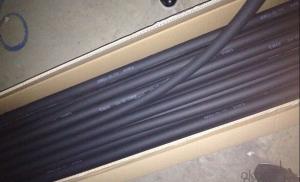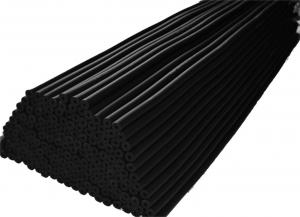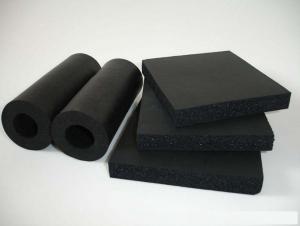Aluminum Foil Facing Rubber Insulation Pipes FM Certified
- Loading Port:
- China Main Port
- Payment Terms:
- TT or LC
- Min Order Qty:
- -
- Supply Capability:
- -
OKorder Service Pledge
OKorder Financial Service
You Might Also Like
1. Flexible Rubber Plastic Insulation Material Product Description
Rubber plastic is a high quality heat-insulating and heat-preservation material which use but yronitrile rubber and polyvinyl chloride(NBR,PVC) as main raw materials. The production process includes mixing, tensing and continuous extruding , heating and foaming.
2.Main Features of Rubber Plastic
-Lower heat-conductivity-Higher fire-blocking performance-Damp-proof and Water-proof-Softness-Neat and -Easy to install easy handing and storage-Good flexibility and tenacity
3.Rubber Plastic Images

4.Rubber Plastic Specification --Rubber Plastic Sheet
Density(kg/m3) | 40-90 | ||||
Thickness(mm) | 10 mm | 15 mm | 20 mm | 25 mm | 30 mm |
Length (m) | 20 | 20 | 10 | 10 | 10 |
Width (m) | 1.5 | 1.5 | 1.5 | 1.5 | 1.5 |
5.FAQ
①How about your company?A world class manufacturer & supplier of HVAC materials,is one of the large-scale professional investment building materials production bases in China.
②How to guarantee the quality of the products?We have established the international advanced quality management system,every link from raw material to final product we have strict quality test;We resolutely put an end to unqualified products flowing into the market. At the same time, we will provide necessary follow-up service assurance.
③How long can we receive the product after purchase? In the purchase of product within three working days, We will arrange the factory delivery as soon as possible. The pecific time of receiving is related to the state and position of customers. Commonly 7 to 10 working days can be served.
- Q: Is it possible to reuse aluminum foil facing after cleaning it?
- <p>Yes, you can reuse aluminum foil facing after washing it, provided it is thoroughly cleaned and dried. Ensure that all residue is removed and it is completely dry to prevent bacterial growth. However, it's important to note that the foil's effectiveness as a barrier may decrease with each use, and it's generally recommended to use a fresh piece for food safety and hygiene, especially when in contact with food.</p>
- Q: This question asks for various purposes that aluminum foil facing can be used for, other than its conventional use.
- <p>Aluminum foil facing has several alternative uses. It can be used as a reflective surface to enhance the heat distribution in grilling or baking. It can also serve as a protective barrier in gardening to deter pests or as a makeshift sled for sliding on snow. Additionally, it can be used to clean stubborn stains or as a shield to protect surfaces from paint splatters during home improvement projects. Some people even use it for crafting or DIY projects due to its malleability and reflective properties.</p>
- Q: Is it possible to use aluminum foil with a reflective side to wrap sandwiches?
- <p>Yes, you can use aluminum foil facing to make sandwiches. The reflective side of aluminum foil is food-safe and can be used to wrap sandwiches for storage or transportation. It helps to keep the sandwich fresh and prevents it from drying out. However, it's important to ensure the foil is clean and free from any sharp edges that might tear the bread or packaging. Additionally, it's best to avoid using foil with non-stick coatings on the inside when in contact with food.</p>
- Q: What are some effective ways to utilize aluminum foil in the kitchen?
- <p>Using aluminum foil effectively in the kitchen can enhance cooking and food preparation. Here are a few tips: 1) Line baking sheets to prevent food from sticking and make cleanup easier. 2) Create a tent over food when roasting to retain moisture and prevent over-browning. 3) Use foil to wrap individual portions for steaming or baking, which can be helpful for portion control. 4) Create a foil packet for cooking fish or vegetables on the grill or in the oven, which helps to steam and retain flavors. 5) Use foil to shape and mold food, such as a bowl for a souffl茅 or a mold for jello. 6) Double or triple layer the foil for durability when wrapping meats or creating containers. 7) Cut a small piece of foil to cover a small dish or to create a makeshift lid. Always handle with care when removing hot foil from the oven, as it can be very hot.</p>
- Q: What are some methods to avoid aluminum foil sticking to food while cooking or baking?
- <p>Yes, there are several ways to prevent aluminum foil from sticking to food. You can lightly grease the foil with cooking spray or oil before placing the food on it. Alternatively, you can use parchment paper or a silicone baking mat between the food and the foil. Another method is to dampen the foil slightly with water, which can create a barrier. Using a non-stick aluminum foil designed for cooking can also be effective. Remember to handle the foil carefully to avoid tearing, especially when greasing or dampening it.</p>
- Q: Is it safe to use aluminum foil as a liner in a slow cooker, and are there any potential risks or benefits?
- <p>Using aluminum foil as a facing in a slow cooker is generally safe. It can help with easy cleanup and may distribute heat evenly. However, it's important to ensure that the foil doesn't touch the heating element, as this can cause damage to both the foil and the slow cooker. Additionally, while aluminum foil is non-toxic and generally safe, there are concerns about potential leaching of aluminum into food, especially with acidic foods. For health-conscious individuals, using a slow cooker liner made from materials like silicone or stainless steel might be a better alternative.</p>
- Q: Explain the various applications of aluminum foil facing in different contexts.
- <p>Aluminum foil facing can be used in various ways depending on the application. In construction, it serves as a vapor barrier to prevent moisture from affecting the insulation. In packaging, it's used for food preservation, providing a barrier against air and light, which helps to keep food fresh. In the automotive industry, it's used for heat reflection and insulation in car engines. It's also used in the manufacturing of reflective materials and in art for creating unique textures and effects. Additionally, aluminum foil facing is utilized in the aerospace industry for heat shielding and in the medical field for sterilization purposes. Each application leverages the properties of aluminum foil, such as its light weight, durability, and heat resistance.</p>
- Q: Is it safe to use aluminum foil that has been recycled, specifically the foil with a shiny side facing outwards?
- <p>Using recycled aluminum foil facing is generally safe, as long as it meets the standards set by regulatory bodies. Recycled aluminum foil is often used in construction materials and insulation due to its durability and insulation properties. However, it's important to ensure that the recycled foil is free from contaminants and is properly processed. For applications where the foil comes into contact with food or the skin, it's crucial to use foil that has been certified safe for such uses. Always check the manufacturer's guidelines and certifications to ensure safety.</p>
- Q: Is it possible to use aluminum foil as a cooking surface? If yes, what are the methods of using it?
- <p>Yes, aluminum foil can be used for cooking. It's commonly used for wrapping foods to retain moisture and heat, such as when baking potatoes or fish. You can also create a foil packet (en papillote) by placing food in the center of a large piece of foil, seasoning it, and then folding the foil to seal the edges. This method steams the food, keeping it moist. For grilling, use heavy-duty foil to prevent tearing and place food directly on it. Remember, avoid using aluminum foil with acidic foods as it can react and leach aluminum into the food.</p>
- Q: Is it possible to use aluminum foil with a reflective side to construct a sandwich?
- <p>While it's technically possible to use aluminum foil facing to make a sandwich, it's not recommended. Aluminum foil is not designed for direct food contact, especially the reflective side which may contain harmful substances that could leach into the food. Instead, use the dull side of the foil or better yet, use food-safe wrap or containers for preparing and storing sandwiches.</p>
Send your message to us
Aluminum Foil Facing Rubber Insulation Pipes FM Certified
- Loading Port:
- China Main Port
- Payment Terms:
- TT or LC
- Min Order Qty:
- -
- Supply Capability:
- -
OKorder Service Pledge
OKorder Financial Service
Similar products
Hot products
Hot Searches
Related keywords



























